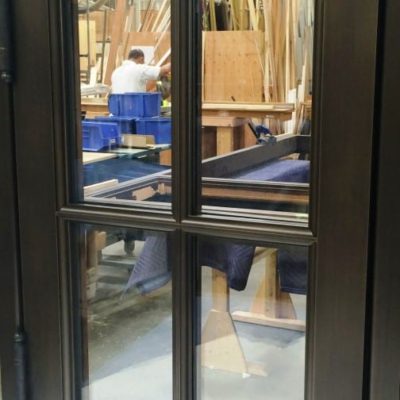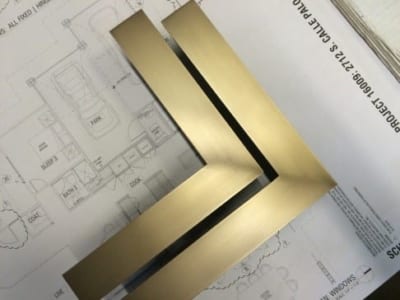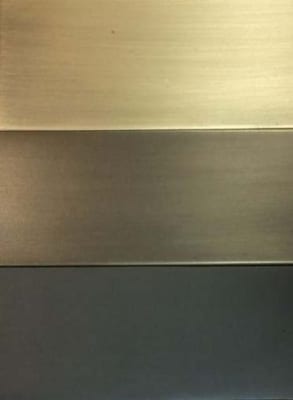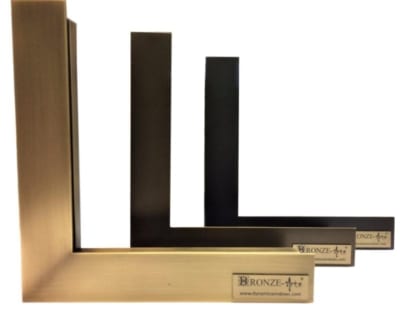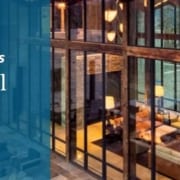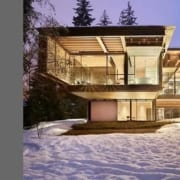A Guide to Patina Finishes for Architectural Bronze Windows
“There’s no way around it – architectural bronze will change as it ages. It’s a matter of perception: whether the change is expected and welcome – or not.”
Bronze is a classic material – timeless and yet so changeable.
The great bronze statues of antiquity didn’t start out looking the way they do today. Nature works its own magic and the bronze changes over time. It’s a living finish.
This is true for bronze windows and doors as well. Architectural bronze windows and doors will change as they age. So the question is, “What are the expectations around the change?” How much change is welcome and expected over the long-term. And, how can you mitigate the change over time — or do you even want to?
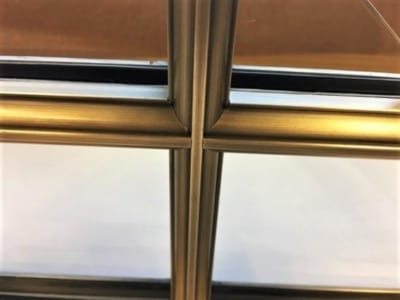
Hand-Applied Artisan Patina Finish on Bronze
The key is to understand everyone’s expectations around Bronze for the long term.
The main way to manage the natural process over time is to select a patina based on the desired aesthetic and environment. Then, to plan for maintaining the bronze cladding over the long-term — which is discussed in a different article (click here).
Understanding a little about the art and science of Bronze patinas can help you select the ideal bronze finish, for both longevity and appearance. Here are a few guidelines for working with architectural bronze from our experience with windows and doors.
Natural Patinas Develop with Time and Exposure
Patina finishes may develop naturally over many years, or they can be created and enhanced through hand-crafted artisan techniques mixed with science. In some cases, patina finishes can even assume new surface textures. Some changes are desirable – others not so much.
A patina is actually considered tarnish, and can refer to any change in surface finish of a material through age and exposure. Patina can occur on metals, wood, leathers and other materials.
Natural patinas are beautiful finishes evolved over many years and decades from exposure to the elements. A natural patina finish contains various chemical compounds, including oxides, carbonates, and sulfates formed on the surface due to exposure to elements in the atmosphere.
You don’t have to do anything to get a natural patina. Just leave the Bronze alone and nature will take care of the rest.
If the patina is left to age naturally, expect to have a range of different finishes, textures and colors.
The natural patina finish is actually a protective layer for the copper and other compounds in bronze. If you’re familiar with Corten steel, this is the same principle. (This is different than natural rusting on steel, which can also be considered a patina finish; however the rust does not protect the iron and instead causes breakdown of the steel.)
Natural patinas are a result of organic changes. As such, the colors will vary over the years from shiny or raw, from brown to black and eventually different shades of green. The percentage of copper in the material will play an important factor to the rate of change and resulting colors.
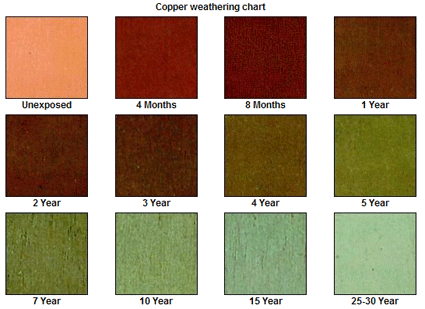
Copper Weathering Chart: An example of the natural weathering of copper (one of the components in architectural bronze).
Architectural bronze is a metal alloy that consists of copper, iron, lead, and zinc. The level of copper determines the high resistance to corrosion, and the level of zinc contributes to the hardness and tensile strength of the material.
As an alloy of several different compounds, architectural bronze will change at a different rate than standalone copper.
(Photo via Crescent City Copper)
Special Considerations with Natural Patinas on Bronze Windows and Doors
The rate of change or finish of the patina will depend on the environment in which the bronze is placed—whether there is clean air or industrial air, humidity, moisture, exposure to salt, and other similar factors.
Natural patinas will develop faster in coastal and marine environments than on dry land or inland locations. We suggest discussing your goals and building location with your supplier if a natural patina is in your sights.
Hand-Applied Artisan Patina Finishes
Hand-applied patina finishes seem to provide a bell-weather for developing trends in architectural finish preferences.
This photo shows a very light, almost natural patina finish on thermally broken bronze window developed for a boutique hotel lobby entrance.
These light patina requests seem to be a growing trend. It wasn’t that long ago that a patina finish on bronze would be called “Oil Rubbed Bronze” and everyone knew pretty much what it was going to look like. That’s no longer the case.
Medium to dark patinas can help in hiding a multitude of sins – inherent defects in the bronze substrate, some of the minor striations from the extrusion process and, of course, the welding of the miter joins.
New application techniques and new welding alloys have changed the aesthetic outcomes of light patinas on bronze. Expectation management remains very important for responsible manufacturers, but there are fewer inherent pitfalls that must be addressed in order for everyone to make a fully informed decision.
The choice of patina today is more clearly an aesthetic preference. Some light patina finishes can appear too consistent, or in some cases cloud the deep luster of the bronze itself – one of its most desirable features for many people. The mottled effect of a naturally-aged bronze surface, encouraged with a medium patina, is often more preferable and blends more consistently with the overall design intent of the envelope. The inherent inconsistencies are a valued element of the aesthetic. The finish is more organic.
Depending on what the Owner wants and expects with a hand-applied “living” finish, it’s worth asking your bronze window fabricator plenty of questions so you can best understand your patina choice.
Gallery: Examples of Patina Options on Architectural Bronze Windows
- Natural Aged Patina on Bronze Window
- Medium-Dark Patina on Architectural Bronze
- Welding with Light Patina Finishes
- Dark Bronze, Medium Bronze, Light Bronze – Bronze Arte Artisan Finishes
- Standard Patina Finishes on Bronze Window Profiles
Patinas are like your kids – you never really know how they’re going to turn out.
The hand-applied patina finishes on Bronze change over time, ideally assuming a naturally-aged aesthetic and subtle mottled character. It’s worth understanding this behaviour so the entire design team is prepared for the changes in appearance.
If hand-applied patinas are not maintained, eventually the organic nature of the material will take over.
Clients may expect Bronze to be “maintenance-free.” It won’t be – unless you actually do just want to let it do its thing, come what may. Bronze will oxidize over time.
If the design intent is to preserve something close to the original patina appearance, it will require maintenance. That is the nature of the material. The rate of change in the patina can be mitigated, but you can’t stop nature. (You’ll find practices for maintaining bronze outlined in our article: The Maintenance-Free Myth: What to Expect with Architectural Bronze Windows & Patina Finishes)
Variables to Consider
How the bronze patina changes over time will depend on several variables.
- Composition of the bronze
- Patination or other protective treatments applied at the factory
- Weather
- Location and exposure to rain, sun, and other climatic conditions
- Atmospheric pollutants
- Scheduled maintenance/cleaning
- Adjacent materials including residual core materials
Understanding what to expect with Bronze and Bronze patinas is as important as with any other variable architectural material, maybe more so given the relative size of the investment. Expecting Bronze to remain unchanged is not realistic. Talk about it. A lot.
Click here to download this blog in PDF format.
Summary
The article delves into the topic of patina finishes for architectural bronze windows and doors, providing an in-depth look at how bronze naturally changes over time. This change, often referred to as a patina, is a result of the material’s exposure to environmental elements such as air, moisture, and pollutants. Patinas can develop organically over many years, giving bronze a distinctive, aged appearance that many find appealing. Alternatively, patinas can be hand-applied using artisan techniques that combine both art and science to achieve a specific look.
The article discusses the importance of understanding and managing expectations when it comes to bronze patinas. It’s crucial to recognize that bronze will inevitably undergo changes in color, texture, and overall appearance. The level of copper in the bronze alloy plays a significant role in the patina’s development, influencing the rate at which the surface evolves from its original state to various shades of brown, black, and eventually green. These changes can be particularly pronounced in environments with high humidity, exposure to saltwater, or industrial pollutants.
Moreover, the article highlights the aesthetic considerations that come with selecting a patina finish. While darker patinas can help to conceal imperfections and inconsistencies in the bronze, lighter patinas may enhance the material’s natural luster but also reveal more of its inherent characteristics. The choice of patina is increasingly seen as a matter of personal or architectural preference, with different finishes offering different visual outcomes. The article also notes the growing trend toward light patina finishes, which differ from the more traditional “Oil Rubbed Bronze” look that was once widely recognized.
To ensure that the desired appearance of bronze is maintained over time, the article underscores the importance of proper care and maintenance. While some clients may expect bronze to be a maintenance-free material, the reality is that ongoing upkeep is necessary to preserve the original patina or to guide the aging process in a controlled manner. The article advises that a thorough discussion with the bronze window fabricator is essential to understand the implications of patina choices and the long-term care required to achieve the desired aesthetic.
Conclusion
In conclusion, the aging process of architectural bronze and the development of patina finishes is a natural and inevitable aspect that requires careful consideration, especially when used in windows and doors. The article emphasizes that bronze is a “living” material, meaning that it will continuously evolve as it interacts with its environment. This evolution can be either embraced as part of the material’s charm or managed through carefully selected patinas and maintenance practices.
The patina finish on bronze is more than just an aesthetic choice; it’s a reflection of how the material will be perceived and how it will fit into its architectural context over time. Whether opting for a natural patina that evolves organically or a hand-applied finish that seeks to achieve a specific look, the decision should be made with a clear understanding of the long-term changes that will occur. The article highlights that the process of patination is influenced by a variety of factors, including the composition of the bronze alloy, environmental conditions, and the level of maintenance provided.
For those who choose to work with architectural bronze, it is crucial to manage expectations realistically. Bronze will not remain static; it will age, and its appearance will change, whether one prefers a subtle, consistent patina or a more varied, organic finish. Proper communication with suppliers and fabricators is key to ensuring that the final product aligns with the client’s vision and the overall design intent of the project.
Ultimately, embracing the natural changes in bronze can add a unique and timeless character to a building, but it requires an understanding that maintenance is part of the commitment to this material. The article concludes by encouraging readers to educate themselves about the behavior of bronze and to engage in thorough planning and discussion to ensure the best possible outcome for their architectural projects.




